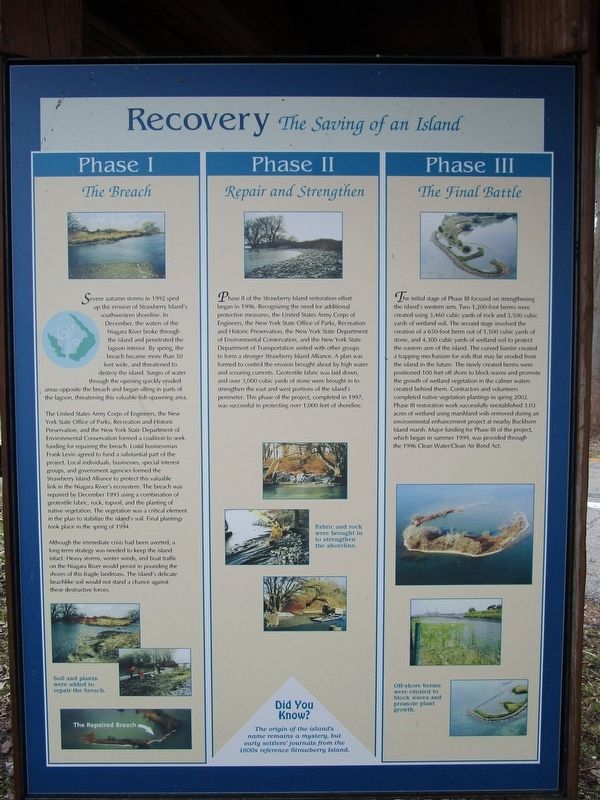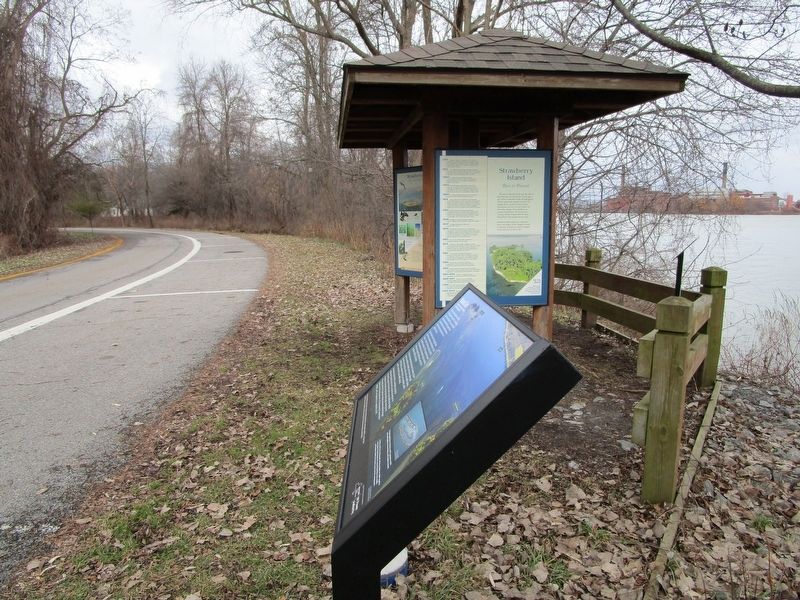Grand Island in Erie County, New York — The American Northeast (Mid-Atlantic)
Recovery
The Saving of an Island
Phase I, The Breach
Severe autumn storms in 1992 sped up the erosion of Stawberry Island's southwestern shoreline. In December, the waters of the Niagara River broke through the island and penetrated the lagoon interior. By spring, the breach became more than 50 feet wide, and threatened to destroy the island. Surges of water through the opening quickly eroded areas opposite the breach and began silting in parts of the lagoon, threatening this valuable fish-spawning area.
The United States Army Corps of Engineers, the New York State Office of Parks, Recreation and Historic Preservation, and the New York State Department of Environmental Conservation formed a coalition to seek funding for repairing the breach. Local businessman Frank Levin agreed to fund a substantial part of the project. Local individuals, businesses, special interest groups, and government agencies formed the Stawberry Island Alliance to protect this valuable link in the Niagara River's ecosystem. The breach was repaired by December 1993 using a combination of geotextile fabric, rock, topsoil, and the planting of native vegetation. The vegetation was a critical element in the plan to stabilize the island's soil. Final plantings took place in the spring of 1994.
Although the immediate crisis had been averted, a long-term strategy was needed to keep the island intact. Heavy storms, winter winds, and boat traffic on the Niagara River would persist in pounding the shores of this fragile landmass. The island's delicate beachlike soil would not stand a chance against these destructive forces.
[caption:] Soil and plants were added to repair the breach. The repaired breach.
Phase II, Repair and Strengthen
Phase II of the Strawberry Island restoration effort began in 1996. Recognizing the need for additional protective measures, the United States Army Corps of Engineers, the New York State Office of Parks, Recreation and Historic Preservation, the New York State Department of Environmental Conservation, and the New York State Department of Transportation united with other groups to form a stronger Strawberry Island Alliance. A plan was formed to control the erosion brought about by high water and scouring currents. Geotextile fabric was laid down, and over 30,000 cubic yards of stone were brought in to strengthen the east and west portions on the island's perimeter. This phase of the project, completed in 1997, was successful in protecting over 1,000 feet of shoreline.
[caption:] Fabric and rock were brought in to strengthen the shoreline.
Did You Know? The origin of the island's name remains a mystery, but early settlers' journals from the 1600s reference Strawberry
Island.
Phase III, The Final Battle
The initial stage of Phase III focused on strengthening the island's western arm. Two 1,200-foot berms were created using 3,460 cubic yards of rock and 5,500 cubic yards of wetland soil. The second stage involved the creation of a 650-foot berm out of 1,500 cubic yards of stone, and 4,300 cubic yards of wetland soil to protect the eastern arm of the island. The curved barrier created a trapping mechanism for soils that may be eroded from the island in the future. The newly created berms were positioned 100 feet off shore to block waves and promote the growth of wetland vegetation in the calmer waters created behind them. Contractors and volunteers completed native vegetation plantings in spring 2002. Phase III restoration work successfully restablished 3.03 acres of wetland using marchland soils removed during an environmental enhancement project at nearby Buckhorn Island march. Major funding for phase III of the project, which began in summer 1999, was provided through the 1996 Claen Water/Clean Air Bond Act. [caption:] Off-shore berms were created to block waves and promote plant growth.
Topics. This historical marker is listed in these topic lists: Environment • Man-Made Features. A significant historical year for this entry is 1992.
Location. 42° 57.551′ N, 78° 56.329′ W. Marker is on Grand Island, New York, in Erie County. Marker is on Park Road Area 3 Loop, on the right when traveling east. Marker is along the park road loop past area 3 in Beaver Island Park. Touch for map. Marker is in this post office area: Grand Island NY 14072, United States of America. Touch for directions.
Other nearby markers. At least 8 other markers are within walking distance of this marker. Management (here, next to this marker); Did You Ever Wonder What It Takes to Restore an Island? (here, next to this marker); Strawberry Island (here, next to this marker); a different marker also named Strawberry Island (here, next to this marker); A Home for Fish (here, next to this marker); Island Life (here, next to this marker); Allenton Farm/Creating Beaver Island State Park (approx. 0.2 miles away); Grover Cleveland & Grand Island / Lewis F. Allen & Western New York (approx. 0.2 miles away). Touch for a list and map of all markers in Grand Island.
Also see . . . Beaver Island - New York State Office of Parks, Recreation & Historic Preservation. Vehicle entrance fee collected in season. (Submitted on January 28, 2017, by Anton Schwarzmueller of Wilson, New York.)
Credits. This page was last revised on January 28, 2017. It was originally submitted on January 28, 2017, by Anton Schwarzmueller of Wilson, New York. This page has been viewed 277 times since then and 11 times this year. Photos: 1, 2. submitted on January 28, 2017, by Anton Schwarzmueller of Wilson, New York.

